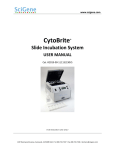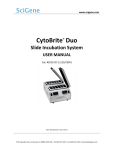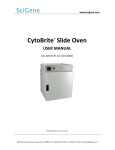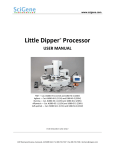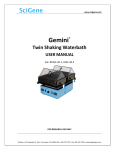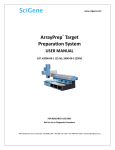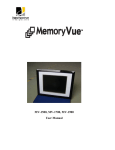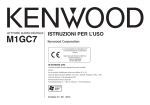Download CytoBrite Slide Incubation System
Transcript
www.scigene.com CytoBrite® Slide Incubation System USER MANUAL Cat. #2019-00-1 (115/230V) FOR RESEARCH USE ONLY 470F Lakeside Drive, Sunnyvale, CA 94085-4720 USA • Tel 408-733-7337 • Fax 408-733-7336 • [email protected] CytoBrite® Slide Incubation System — USER MANUAL Serial Number The following serial number identifies the specific instrument you have purchased and must be referenced when requesting service. A copy is affixed to the instrument. Technical Service: (408) 733-7337, [email protected] Warranty SciGene warrants that the CytoBrite® Slide Incubation System described in this manual shall be free of defects in materials and workmanship for a period of 12 months from date of delivery. This warranty does not cover removable slide trays or accessories. In the event of a defect during the warranty period, SciGene’s limit of liability will be to, at its sole discretion: (a) provide replacement parts; (b) perform factory repairs; or (c) replace the product. The foregoing warranty is void in the event the unit was abused or modified or used in a manner inconsistent with its intended purpose. SciGene makes no other warranty, expressed or implied including warranties of merchantability and fitness for a particular purpose. In no event shall SciGene be liable for any direct, indirect, special, incidental or consequential damagers or for any damages resulting from loss arising out of or in connection with the sale, use or performance of the product. Copyright Copyright ©2014 SciGene Corporation. All rights reserved. SciGene, CytoBrite and CytoBond are trademarks of SciGene Corporation, Sunnyvale, CA. All other trademarks used in this manual are the property of their respective owners. Version 1.0A, October 2014 1 (408) 733-7337, [email protected] CytoBrite® Slide Incubation System — USER MANUAL Table of Contents I. SAFETY NOTICES ....................................................................................................................... 3 A. Intended Use ................................................................................................................................. 3 B. Instrument Safety ......................................................................................................................... 3 C. Symbols and Conventions ............................................................................................................. 3 D. Warnings ....................................................................................................................................... 4 E. Cautions ........................................................................................................................................ 5 F. Compliance ................................................................................................................................... 5 II. UNPACKING AND SET UP .......................................................................................................... 7 A. Unpacking the Instrument ............................................................................................................ 7 B. Parts Provided ............................................................................................................................... 7 C. Coverslip Sealant Provided ........................................................................................................... 7 D. Environmental Requirements ....................................................................................................... 7 E. Installing the Instrument .............................................................................................................. 7 III. USING YOUR CYTOBRITE SYSTEM .............................................................................................. 8 A. System Components ..................................................................................................................... 8 B. Preparing Slides / Loading the Instrument / Starting a Protocol .................................................. 9 C. Powering On/Off ........................................................................................................................... 9 D. Using the Controller ...................................................................................................................... 9 E. Using the USB Drive ...................................................................................................................... 9 IV. CREATING AND EDITING PROTOCOLS ...................................................................................... 10 A. Creating a Protocol ..................................................................................................................... 10 B. Editing a Protocol ........................................................................................................................ 11 V. ONETEMP MODE .................................................................................................................... 12 VI. RUNNING A PROTOCOL .......................................................................................................... 13 VII. MANAGING FILES .................................................................................................................... 14 A. Viewing a Protocol ...................................................................................................................... 14 B. Copying a Protocol ...................................................................................................................... 14 C. Renaming a Protocol ................................................................................................................... 14 D. Deleting a Protocol ..................................................................................................................... 14 VIII. SETTINGS AND PREFERENCES .................................................................................................. 15 A. Datalogging to USB Key............................................................................................................... 15 B. Calibrating Slide Block Temperature .......................................................................................... 16 C. Upgrading Software .................................................................................................................... 17 D. Changing Alert Sounds ................................................................................................................ 17 IX. MAINTENANCE ....................................................................................................................... 18 A. Cleaning the Instrument ............................................................................................................. 18 B. Cleaning Air Vents ....................................................................................................................... 18 C. Checking and Replacing Fuses .................................................................................................... 18 X. TROUBLESHOOTING................................................................................................................ 19 XI. SPECIFICATIONS ...................................................................................................................... 19 XII. ORDERING INFORMATION ...................................................................................................... 20 Version 1.0A, October 2014 2 (408) 733-7337, [email protected] CytoBrite® Slide Incubation System — USER MANUAL I. SAFETY NOTICES A. Intended Use The CytoBrite® Slide Incubation System is intended for the heating and cooling of biological samples. The instrument should only be used according to instructions provided in this User Manual and other SciGene technical documents. If the equipment is used in a manner not specified by the manufacturer, the protection provided by the equipment may be impaired. La CytoBrite système est destiné pour le chauffage et le refroidissement d'échantillons biologiques. L'instrument ne devrait servir que selon les instructions fournies dans ce manuel de l'utilisateur et d'autres documents techniques de SciGene. Si l'équipement est utilisé de manière non spécifiée par le fabricant, la protection assurée par l'équipement peut être compromise. B. Instrument Safety Before operating the instrument, read the information in this section concerning hazards and potential hazards. Ensure that anyone involved with the instrument’s operation is instructed in both general safety practices for laboratories and specific safety practices for the instrument. Avant le fonctionnement de l'instrument, lisez les renseignements dans cette section concernant les risques et les dangers potentiels. S'assurer que toute personne impliquée avec le fonctionnement de l'instrument est instruit dans les pratiques générales de sécurité pour les laboratoires et les pratiques de sécurité spécifiques pour l'instrument. Avant le fonctionnement de l'instrument, lisez les renseignements dans cette section concernant les risques et les dangers potentiels. S'assurer que toute personne impliquée avec le fonctionnement de l'instrument est instruit dans les pratiques générales de sécurité pour les laboratoires et les pratiques de sécurité spécifiques pour l'instrument. C. Symbols and Conventions The following chart is an illustrated glossary of the electrical symbols used on the CytoBrite System. Whenever such symbols appear on instruments, please observe appropriate safety measures. Le tableau suivant est un glossaire illustré des symboles électriques qui sont utilisées sur le système. Chaque fois que ces symboles apparaissent sur les instruments, veuillez observer les mesures de sécurité appropriées. 1. Electrical Symbols This symbol indicates that this is a protected ground terminal that must be connected to earth ground before any other electrical connections are made to the instrument. Ce symbole indique qu'il s'agit d'un terminal de terrain protégé qui doit être connecté à la terre avant que toutes les autres connexions électriques sont apportées à l'instrument. Version 1.0A, October 2014 3 (408) 733-7337, [email protected] CytoBrite® Slide Incubation System — USER MANUAL CAUTION: This symbol alerts you to consult this Operator’s Manual for further information and to proceed with caution. ATTENTION: Ce symbole vous avertit à consulter ce guide de l'utilisateur pour plus d'informations et de procéder avec prudence. This symbol indicates the OFF position of the main POWER switch. Ce symbole indique la position OFF de l'interrupteur principal. This symbol indicates the ON position of the main POWER switch. Ce symbole indique la position ON de l'interrupteur principal. 2. Non-Electrical Symbols CAUTION: This symbol illustrates a heat hazard. Proceed with caution when working around these areas to avoid being burned by hot components. ATTENTION : Ce symbole illustre un danger pour la chaleur. Faire preuve de prudence lorsque vous travaillez autour de ces zones pour éviter d'être brûlé par les composants du chauds. CAUTION: This symbol alerts you to consult this Operator’s Manual for further information and to proceed with caution. ATTENTION : Ce symbole vous avertit à consulter ce guide de l'utilisateur pour plus d'informations et de procéder avec prudence. D. Warnings Failure to comply with the following warnings that are affixed to the product can lead to possible personal injury or death. Défaut de respecter les avertissements suivants qui sont apposées sur le produit peut conduire à possibles lésions corporelles ou la mort. This symbol on the rear of the instrument indicates the presence of the fuse box. Warning: For Continued Protection Against Fire, Replace Only with Same Type Rating of Fuse. Always disconnect the power cord before attempting to replace the fuse. Ce symbole sur l'arrière de l'instrument indique la présence de la boîte de fusibles. Avertissement : Pour le maintien de la Protection contre l'incendie, remplacer uniquement avec la même cote de Type de fusible. Toujours débrancher le cordon d'alimentation avant d'essayer de remplacer le fusible. Version 1.0A, October 2014 4 (408) 733-7337, [email protected] CytoBrite® Slide Incubation System — USER MANUAL E. Cautions Failure to comply with the following cautionary statement affixed to the product may lead to possible personal injury. Omission de se conformer à la mise en garde suivante apposée sur le produit peut entraîner des blessures possibles. This symbol located both on and in front of the lid indicates the potential presence of a Hot Surface. Use care when working in this area to avoid being burned. Ce symbole situé sur et devant le couvercle indique la présence possible d'une Surface chaude. Faire preuve de diligence lorsqu'il travaille dans ce domaine pour éviter d'être brûlé. This symbol located on the back of the instrument warns the user to select the correct voltage before connecting the power cord. Operating with the voltage selector switch in the wrong position will damage the instrument and create a safety hazard. Ce symbole situé à l'arrière de l'appareil avertit l'utilisateur de sélectionner la tension correcte avant de brancher le cordon d'alimentation. Fonctionnant avec le sélecteur de tension dans la mauvaise position peut endommager l'appareil et créer un risque de sécurité. F. Compliance 1. European Conformity (CE) This symbol indicates the instrument is in compliance with all applicable European Union Electromagnetic Compatibility and Low Voltage Directives. 2. Waste Electrical & Electronic Equipment Directive (WEEE) This symbol indicates the instrument is required to comply with the European Union’s Waste Electrical & Electronic Equipment (WEEE) Directive 2002/96/EC, providing environmentally safe disposal of end of life equipment through recycling. Contact your institution to provide environmentally safe disposal. If this is not available, contact your local SciGene distributor or SciGene Technical Support [[email protected]] for assistance. Do not treat electrical and electronic equipment as unsorted municipal waste. RoHS 3. Restriction of Hazardous Substances (RoHS) This symbol indicates the instrument is in compliance with the European Union’s (RoHS 2) Directive 2011/65/EU on the restriction of the use of certain hazardous substances in electrical and electronic equipment (EEE). Version 1.0A, October 2014 5 (408) 733-7337, [email protected] CytoBrite® Slide Incubation System — USER MANUAL 4. Electromagnetic Compatibility (EMC) The CytoBrite System is a Class A digital device under FCC Title 47 Part 15B and designated as Class A electrical equipment for measurement, control, and laboratory use (EN61326). Note regarding Canadian EMC compliance: Le present appareil numerique n’emet pas de bruits radioelectrique depassant les limites applicables aux appareils numeriques de class A prescrites dans le reglement sur le brouillage radioelectrique edicte par le Ministere des Communications du Canada. 5. FCC Warnings and Notes This equipment has been tested and found to comply with the limits for a Class A digital device, pursuant to part 15 of the FCC Rules. The instrument qualifies as an “exempted device” under 47 CFR 15.103(c), in regard to the cited FCC regulations in effect at the time of manufacture. Shielded cables must be used with this unit to ensure compliance with the Class A FCC limits. Version 1.0A, October 2014 6 (408) 733-7337, [email protected] CytoBrite® Slide Incubation System — USER MANUAL II. UNPACKING AND SET UP A. Unpacking the Instrument The CytoBrite instrument is shipped in a double carton. To unpack the instrument, open the outer box, take out the bag containing the manual and power cord and remove the protective cardboard corners. Then open the inner box, reach down the inside, and carefully lift out the instrument by its base. NEVER lift by the hinged lid. Place the instrument on the bench and raise the lid to remove two slide trays. Inspect parts for visible damage. If any damage is evident, retain all shipping materials and contact SciGene [[email protected]] or your local distributor. B. Parts Provided • 2x Slide Trays (shipped inside instrument) • Power Cord • User Manual C. Coverslip Sealant Provided One complimentary 100 ml bottle of CytoBond® Removable Coverslip Sealant (SciGene cat. # 2020-00-1) is shipped separately from the instrument. Use of CytoBond Sealant is required for sealing coverslips; to prevent probe evaporation without humidification. Contact SciGene [[email protected]] or your local distributor to order additional bottles. D. Environmental Requirements Ensure that the area where the CytoBrite System is installed meets the following conditions, for reasons of safety and performance: Ambient temperature +15 to +32°C (58 to 90°F) Relative humidity 20 to 80% RH non-condensing Air flow clearance 6 inches (15 cm) minimum on both sides E. Installing the Instrument Place the instrument on a level surface within a few feet of the power source. Position the system so the lid can be easily opened without interference. Allow 18 inches of vertical clearance and 16 inches of horizontal clearance. Ensure 3 inches of clearance at the back to attach the power cord. Using only the power cord provided, plug it into the back of the unit and then to a properly grounded outlet. Turn on power using the ON/OFF switch on the front control panel. Allow 18 inches of vertical clearance to open the lid. Allow 3 inches of clearance at the back for the power cord. Allow 16 inches of horizontal clearance for air flow. Version 1.0A, October 2014 7 (408) 733-7337, [email protected] CytoBrite® Slide Incubation System — USER MANUAL III. USING YOUR CYTOBRITE SYSTEM A. System Components Component SlideSense™ Temperature Sensor Function Senses and transmits slide block temperature information to controller Used to program and monitor instrument operation and report slide block temperature Holds slides during sample preparation and incubation Turns on main power to unit Used for saving datalog files and installing software Covers slide trays during processing Connection for digital thermometer cable to calibrate slide block temperature Location of main fuses and power cord connection Seals coverslips to slides Temperature Controller Slide Tray Power Switch USB Port Hinged Lid Block Temperature Calibration Jack Power Input Module and Fuse Housing CytoBond Removable Coverslip Sealant Version 1.0A, October 2014 8 (408) 733-7337, [email protected] CytoBrite® Slide Incubation System — USER MANUAL B. Preparing Slides / Loading the Instrument / Starting a Protocol Slides are prepared for molecular analysis following your standard procedures using the CytoBrite Slide Trays provided with the unit. CytoBond® Removable Coverslip Sealant (SciGene cat. # 2020-00-1) is used in place of rubber cement for sealing coverslips to prevent probe evaporation without humidification. 1. Place slides to be analyzed in the tray(s), pipet probes and place coverslips. 2. Seal coverslips by dispensing a continuous bead of CytoBond Sealant around edges. 3. Turn on power to the instrument, select and start the desired program (See section V for how to create programs.) 4. When the unit finishes pre-heating, the controller displays a prompt and beeps to load slides. Raise the cover, place the tray(s) into the unit and press Select to start the program. 5. The instrument then heats the slides to the programmed temperatures and times. C. Powering On/Off To turn ON the instrument, press the top of the power switch (the “l” position). To turn OFF the instrument, press the bottom of the power switch (the “O” position). D. Using the Controller A 4-line LED display controller is used to CREATE, RUN, EDIT and VIEW protocols, manage FILES (rename, copy, delete) and customize SETTINGS (including calibrating temperature and choosing alert sounds). Navigating menus and selecting options is performed with four buttons on the display panel: • Home — returns to the main menu screen. • Select — chooses the option highlighted in the display. • Forward — increments or toggles between options. • Back — returns to a previous screen or option. Details on using controller menus can be found in later sections of this manual. E. Using the USB Drive A USB key inserted into the USB DRIVE can be used to: • • • • Capture a time and temperature log when running a protocol Allow protocols to run directly from a USB key. Provide additional capacity for storing protocols beyond the 10 file storage limit on the controller. Upload new controller software. Version 1.0A, October 2014 9 (408) 733-7337, [email protected] CytoBrite® Slide Incubation System — USER MANUAL IV. CREATING AND EDITING PROTOCOLS A. Creating a Protocol Protocols are created and saved in memory on the controller (10 files maximum) or a USB key. Names are 8 alphanumeric characters in length including spaces. For FISH/ISH methods, protocols can be created with an optional co-denaturation step prior to probe hybridization. Creating a Protocol Run View Files CytoBrite Create Edit Settings CREATE Enter Name: FISH101A 1. From the Home screen, select Create. 2. Enter the name of the protocol by scrolling through the CREATE Yes FISH101A alphanumeric characters (space: A-Z; 0-9) using the Denature? Yes Forward button. Sequentially select a desired character using the Select button. Names must be 8 CREATE characters in length, including spaces. FISH101A Denature Temp: 3. On the next screen select Yes to use a 73C Denature step. If chosen, enter the Denature time (hours | minutes | seconds) and CREATE FISH101A temperature (15-90°C) on succeeding screens. Denature Time: 00:02:00 4. On the following screens, enter the slide incubation temperature and time for the probe hybridization step. 5. Complete creation of the protocol by choosing how to end the protocol. Selecting Off turns off the slide block. Selecting Hold keeps the slides at a selected temperature until removed. 6. If Hold is selected as the protocol end option, enter a Hold temperature. 7. Save the completed protocol to the controller memory or a USB key. Make sure a USB key is inserted BEFORE selecting the USB option. No No CREATE FISH101A Incubate Temp: 37C CREATE FISH101A Incubate Time: 16:00:00 Off CREATE FISH101A Protocol End: Off Hold Hold CREATE FISH101A Hold Temp: 37C CREATE FISH101A Save in? CytoBrite USB Return to Home screen Version 1.0A, October 2014 10 (408) 733-7337, [email protected] CytoBrite® Slide Incubation System — USER MANUAL B. Editing a Protocol The Edit function allows changes to the Denature and Incubate times and temperatures as well as protocol end options (Off or Hold) in an existing protocol. Edited protocols may be saved under the existing name or be renamed (using the Save As function) to the controller memory or USB key. Editing a Protocol 1. Select Edit from the Home screen. 2. Choose the file location (controller memory or USB key) and the protocol to edit. 3. Select Denature, Incubate or End step to edit. 4. Make changes to time (hours | minutes | seconds) and/or temperature (15-90°C) for the selected step. 5. Confirm changes then select Finish and Save or Continue Edits. 6. Save edited file to memory or USB key. Denature To rename file, select Save As and create new name before saving. CytoBrite Run View Files Create Edit Settings EDIT File Location: CytoBrite USB EDIT Select File: 1) FILE100 2) FILE200 EDIT: File100 Denature ON Incubate End Incubate End EDIT: File100 Denature? Yes Yes Yes EDIT: File100 End No Off Set Temp and Time Con nue Edits No EDIT: File100 Temp: 73 Time: 00:02:00 OK? Yes No EDIT: File100 Denature Off? EDIT: File100 Hold Temp: 37 Select New Temp Yes No Hold Off EDIT: File100 Denature Temp: 73 Time: 00:02:00 Hold EDIT: File100 Incubate Temp: 37 Time: 14:00:00 EDIT: File100 Temp: 37 Time: 16:00:00 OK? Yes No Yes No Yes EDIT: File100 Finish and Save Continue Edits Finish EDIT: File100 Save As Save Save As Save EDIT: EDIT: File100 Save in CytoBrite Enter Name File101 USB CytoBrite EDIT: File100 Save in CytoBrite? Yes No Return to Home screen Version 1.0A, October 2014 11 (408) 733-7337, [email protected] CytoBrite® Slide Incubation System — USER MANUAL V. ONETEMP MODE The CytoBrite System can be operated to maintain a single block Running OneTemp Mode temperature from 15 to 90°C using the OneTemp mode. CytoBrite For information on creating and saving multi-temperature and multi-step protocols, see section V. CREATING AND EDITING PROTOCOLS. 1. From the Home screen, choose Run | OneTemp. Run View Files Create Edit Settings RUN: Operating Mode OneTemp Protocol 2. Set the desired block temperature from 15 to 90°C. 3. Press Select “Yes” to start the program. Set temperatures for the block will be displayed. Time will be listed as “Forever” as the program will continue until stopped by the user. 4. To end the program, use the Forward button to display the End Protocol screen and Select “Yes”. The instrument will display “OneTemp DONE” and total elapsed time. RUN: OneTemp Set Temp: 73C No Temp: 37C Time: Forever Start Yes No RUN: OneTemp Temp: 73.2 / 73C Time: 05:00:00 No End OneTemp? Yes No Yes OneTemp DONE Time: 00:01:01 Return to Home screen Version 1.0A, October 2014 12 (408) 733-7337, [email protected] CytoBrite® Slide Incubation System — USER MANUAL VI. RUNNING A PROTOCOL The RUN function is used to run a previously created protocol stored in the controller memory or on a USB key. To operate the CytoBrite instrument at a single temperature without a timer see section V. ONETEMP MODE. Running a Protocol 1. Select Run | Protocol from the Home screen. 2. Choose the file location (CytoBrite or USB key) CytoBrite Run Create and select the protocol. The protocol will start by View Edit Files Settings performing a 15 minute preheating of the block to the programmed incubation temperature. RUN Operating Mode: 3. When the preheat step is complete, the display OneTemp Protocol will flash “Load Slides / Press Select”. 4. Open the lid, load the tray(s) and press Select. RUN File Location: 5. If a denaturation step is part of the protocol, the unit will rapidly heat and hold at denature CytoBrite USB temperature, then rapidly cool to incubate RUN temperature, warming for a preset time, Select File: as programmed by the operator. 1) File100 2) File200 6. If a denaturation step is not used, the unit No will simply heat to the incubate temperature RUN Run Protocol? where the slides will be warmed File100 for the programmed time. Yes No Yes 7. If “Off” was selected as the program ending RUN: File100 option, slide block heating will turn off at the Preheats for 15 minutes at Preheat: 36.9 completion of the protocol. If “Hold” was Temp: 37 programmed temperature. Time: 00:05:00 selected, the slide block will be held at the programmed temperature. RUN Incuba ng Only 8. Press any key to terminate a protocol. If Denaturing Preheat Complete Load Slides/ Press Select 9. Select Yes in the Turn Off Block Unit beeps to load slides. confirmation screen to RUN: File100 RUN:File100 Mode: Denature Mode: Incubate return to the Home screen. Temp: Time: 72.9 00:05:00 Temp: Time: 37.1 / 37 16:00:00 OFF HOLD File100: DONE Time: 16:00:00 Temp: Off File100: DONE Time: 16:00:00 Temp: 37.1 No File100: DONE Turn off block + return to home? Yes No Return to Home screen Version 1.0A, October 2014 13 (408) 733-7337, [email protected] CytoBrite® Slide Incubation System — USER MANUAL VII. MANAGING FILES A. Viewing a Protocol Saved protocols can be reviewed in read-only mode. 1. Select View from the Home screen. 2. Choose the file location (controller memory or USB key) and protocol. 3. Use Forward to advance through the protocol in the following order: • Denature temperature and time • Incubate temperature and time • Final hold temperature or OFF 4. Press the Forward or Back buttons to continue. B. Copying a Protocol A protocol can be copied and saved under a new name in the controller memory or USB key. Copy/Rename/Delete a Protocol Run View Files 1. Select Files from the Home screen. 2. Choose the file location (controller memory or USB key) and protocol. 3. Select Copy. 4. Choose new file location and Select Yes. Create Edit Settings FILES File Location: CytoBrite USB Key FILES CytoBrite Folder Select File: 1) 37to4 C. Renaming a Protocol An existing file may be renamed and saved in the controller memory or USB key. 1. Select Files from the Home screen. 2. Choose the file location (controller memory or USB key). FILES 3. Select Name. File: 37to4 Copy to: 4. Enter a new name by USB Key choosing characters No (space; A-Z; 0-9) using FILES Copy 37to4 to the Forward button. USB key? Yes Sequentially select a desired character using the Select button. Protocol names must be 8 characters in length, including spaces. 5. Select Yes to save. CytoBrite Copy FILES CytoBrite Folder File: 37to4 Copy Name Delete Delete Name FILES File: 37to4 Enter new name 37to65 FILES Delete: 37to4 Yes No FILES File: 37to65 Finish and save? Yes Yes No Return to Home screen D. Deleting a Protocol 1. Select Files from the Home screen. 2. Choose the file location (controller memory or USB key) and protocol. 3. Choose Delete and press Select. 4. Select Yes to confirm. Version 1.0A, October 2014 14 No No (408) 733-7337, [email protected] CytoBrite® Slide Incubation System — USER MANUAL VIII. SETTINGS AND PREFERENCES A. Datalogging to USB Key A text file that captures the block time and temperature while a protocol is running can be created and written to the USB key. 1. From the Home screen, go to Settings | Datalog 2. Following the prompts on the screen, turn on datalogging and enter the data sampling frequency (5 sec to 60 min). 3. Insert a USB key into the USB DRIVE to capture a log file. While in use, the drive light will flash as data is transferred to the USB key. A datalog file for a typical protocol is shown below: Creating a Datalog Run View Files CytoBrite Create Edit Settings SETTINGS 1) Datalog 2) Calibrate 3) Sounds 4) Upgrade SW If set to OFF SETTINGS Datalogging Off Turn On? Yes No ▲ ▼ If set to ON SETTINGS Datalogging On Turn Off? Change Yes Enter Datalog Frequency (5 sec—60 min) Change 00 min 05 sec Datalog Frequency 00 min 05 sec Ok? Yes No Return to Se ngs Datalog file for a typical protocol Version 1.0A, October 2014 15 (408) 733-7337, [email protected] Off CytoBrite® Slide Incubation System — USER MANUAL B. Calibrating Slide Block Temperature Calibrating Block Temp The CytoBrite System comes calibrated from the factory to provide accurate slide temperatures from 15 to 90°C ± 0.5°C. The accuracy of block temperatures should be checked periodically (according to your lab schedule) with a T-type NIST certified digital thermometer (SciGene cat. #1051-52-0). The controller needs calibration only if the block temperature shown on the NIST-certified thermometer differs by more than one degree (1°C) from the temperature shown on the controller display. 1. Connect a T-type NIST certified digital thermometer (ScIGene cat. # 1051-52-0) to the blue jack on the back of the unit labeled “Temperature Calibration”. 2. From the Home screen, go to Settings | Calibrate. 3. Enter 75°C as set temperature and confirm. The block temperature and current offset will be shown. 4. Wait 30 minutes. 5. Calculate the difference between the temperature shown on the digital thermometer and the block temperature shown on the controller display to determine the needed offset adjustment. For example, if the thermometer reads 76.0°C and the controller reads 75.0°C, the offset adjustment is 1.0. 6. Add this adjustment value to the existing offset shown on the controller display to determine a new offset then enter the new value using the Forward and Back buttons. For example, if the offset value on the display before adjustment is 0.3, and the adjustment value from step 5 is 1.0, the new offset value to be entered into the controller would be 1.3. 7. Select Yes to confirm the new offset and return to Home screen. Version 1.0A, October 2014 16 Run View Files CytoBrite Create Edit Settings SETTINGS 1) Datalog 2) Calibrate 3) Sounds 4) Upgrade SW ▲ ▼ SETTINGS Calibrate Block Set Temp: 75C SETTINGS Calibrate Block Set Temp: 75C Yes No SETTINGS Block Temp: 75.0 Offset:: 0.3 SETTINGS Block Temp: 75.0 OK?: Yes No SETTINGS Calibration Complete at 75C Press any key Return to Home screen (408) 733-7337, [email protected] CytoBrite® Slide Incubation System — USER MANUAL C. Upgrading Software Upgrading Software The CytoBrite System displays the current software version on the controller when powering on the instrument (during boot up). New software versions are installed via the USB DRIVE. Current software versions may be downloaded from www.scigene.com. 1. From the Home screen, go to Settings | Upgrade SW. 2. Following the on-screen prompts, insert a USB key containing new software into the USB DRIVE and press Select. 3. A flashing progress indicator displays as the software is loading. This process may take several minutes. 4. When loading is finished, an “Upgrade Complete” message will display. Press any key to display the new software version number and date. After a few seconds the Home screen will appear. The instrument is now ready for use. Run View Files CytoBrite Create Edit Settings SETTINGS 1) Block Type 2) Calibrate 3) Upgrade SW 4) Sounds ▲ ▼ SETTINGS Upgrade Software Insert USB + press Select Upgrading * * * * * * * * * **************** * * * * * * * * * * * * * * ... Upgrade Complete D. Changing Alert Sounds Press any key The CytoBrite System comes from the factory with alert sounds set to OFF. Alert sounds can be turned ON to notify the user of the following events: • Protocol End – two long beeps at protocol completion • Each Select – one short beep each time Select button is pressed • Preheat – continuously beeps upon reaching set temperature until Select button is pressed • Denature – one short beep indicates this step has completed To turn sounds on or off: SciGene Version x.x Month / Day / Year Return to Se ngs Changing Sounds Run View Files 1. From the Home screen, go to Settings | Sounds. 2. Use the Forward button to choose an alert from the list and press Select. 3. Use Forward to choose ON or OFF and press Select. CytoBrite Create Edit Settings SETTINGS 1) Block Type 2) Calibrate 3) Sounds 4) Upgrade SW 4. Continue to change alert settings as in step 2 above or exit to the Home screen by pressing the Back button twice. ▲ ▼ Sounds SETTINGS Beep After 1) Protocol End 2) Each Select 3) Preheat 4) Denature Off ▲ Off ▼ Off Off SETTINGS Beep After Each Select (etc.) On Off On SETTINGS Beep After 1) Each Select On ▲ 2) Each Step Off ▼ Return to Se ngs Version 1.0A, October 2014 17 (408) 733-7337, [email protected] CytoBrite® Slide Incubation System — USER MANUAL IX. MAINTENANCE A. Cleaning the Instrument Clean outer metal surfaces and the heated lid using a soft cloth and mild, detergent-based cleaner. Avoid abrasive cleaners that can scratch surfaces. Do NOT use caustic or strongly alkaline solutions (e.g., strong soaps, ammonia, or bleach at a higher concentration than specified above). If running radioactive or biohazardous reactions, consult your institution’s radiation safety officer or biosafety office for assistance. Turn the power switch to the OFF position and unplug the power cord before performing any cleaning procedure!! Tournez le commutateur d'alimentation sur la position OFF et débranchez le cordon d'alimentation avant d'effectuer toute opération de nettoyage! Remove liquid or condensation (wipe dry) while instrument is OFF and block is cool or at room temperature!! Enlever le liquide ou la condensation (essuyer), tandis que l'instrument est éteint et le bloc est frais ou à température ambiante! B. Cleaning Air Vents Clean the air intake (bottom of instrument) to prevent vents from becoming clogged. Remove any dust and debris, airflow may be hampered, effecting performance of the instrument and damage by overheating of components. C. Checking and Replacing Fuses There are two fuses located in a removable fuse block below the power cord receptacle on the back of the unit. A blown fuse appears dark. Always replace fuses with those of the same amperage and voltage as shown on the label below the fuse block. Turn the power switch to the OFF position and unplug the power cord before performing any service procedure. To remove fuses: 1. Insert a small, flat blade screwdriver into the tab recess just below the plug receptacle. 2. Push down to release the fuse block. 3. Slide fuse holder out from the fuse block while holding the retaining tab out of the way. 4. Gently pry out the fuses. Pry open tab with screwdriver Fuse holder Push clip up to release Fuse block Version 1.0A, October 2014 18 (408) 733-7337, [email protected] CytoBrite® Slide Incubation System — USER MANUAL X. TROUBLESHOOTING Symptom Cause Solution Instrument does not turn on. Blown fuse(s) Replace fuse(s) on back of unit, beneath power cord receptacle. Block is not reaching set temperature. Paper or other object blocking fans Check underneath CytoBrite™ base for objects blocking the fans. Ensure proper clearance. XI. SPECIFICATIONS Electrical Cat. #2019-00-1 115/230V AC; 50/60 Hz; 3A/1.6A Dimensions (cover closed) Outside H x W x D 9.25 x 9 x 12.75 inches (24 x 23 x 32 cm) Weight Instrument 15 lbs (7 kg) net Performance Block Temperature Range Block Temperature Regulation 15 to 90°C ± 0.2°C from set point Block Temperature Accuracy ± 0.5°C Slide-to-slide Temperature Variation < 1.0°C Heating Rate 37 to 75°C in < 2 minutes Cooling Rate 75 to 37°C in < 2 minutes Controller Controller Type Display Calibration Output Digital PID, single loop Four line LED Thermocouple Environmental Ambient temperature Operation: +15 to +32°C (58 to 90°F) Storage: -20 to +60°C (-4 to 140°F) Relative humidity Operation: 20 to 80% RH non-condensing Storage: 10 to 90% RH non-condensing Overvoltage category Version 1.0A, October 2014 II 19 (408) 733-7337, [email protected] CytoBrite® Slide Incubation System — USER MANUAL XII. ORDERING INFORMATION Cat. # Description UoM 2019-70-1 CytoBrite Slide Oven, 115V. Includes ten 6-slide racks. EA 2019-20-1 CytoBrite Duo Slide Incubation System, 115/230V. Includes two 6-slide racks. EA 2019-10-0 CytoBrite Slide tray. Holds 1 to 6 slides. EA 2010-00-1 FISH Wash Buffer 1 (0.4xSSC/0.3% IGEPAL, pH 7). EA 2010-00-2 FISH Wash Buffer 2 (2xSSC/0.1% IGEPAL, pH 7). EA 2020-00-1 CytoBond Removable Coverslip Sealant, 100 ml. EA 2022-00-2 CytoZyme Stabilized Pepsin, 50X Concentrate, 20 ml. EA 2022-00-3 CytoZyme Stabilized Pepsin, 50X Concentrate, 100 ml. EA 2022-10-2 CytoZyme Reaction Buffer, 1L. EA 2022-10-3 CytoZyme Reaction Buffer, 4L. EA 2030-00-1 Sodium Thiocyanate Pretreatment Reagent, 1L EA 2030-00-2 Sodium Thiocyanate Pretreatment Reagent, 4L EA 1051-52-0 Digital thermometer. Includes cable and NIST certificate EA Version 1.0A, October 2014 20 (408) 733-7337, [email protected]






















